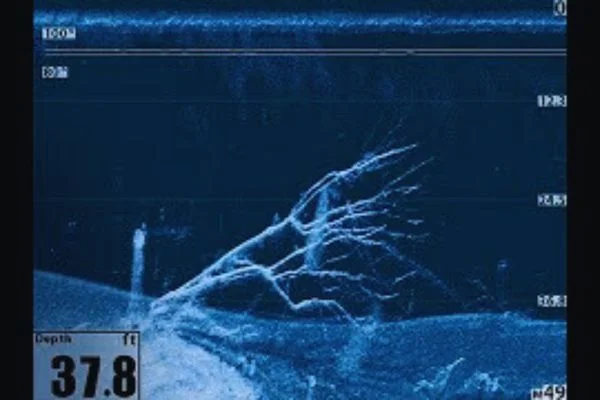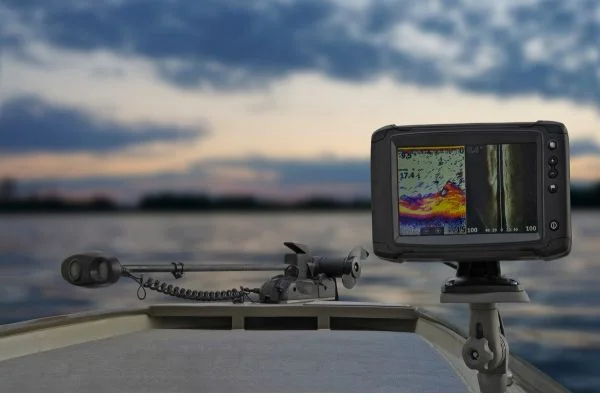If you’re an avid fishing enthusiast, you’ve probably heard about down imaging and how it can help improve your chances of catching fish. But what is down imaging on a fish finder? Down imaging is a technology used on fish finders that helps anglers locate and identify structures in the water below them. It’s like having X-ray vision into the underwater environment. Let’s take a closer look at how this revolutionary technology works.
What Is Down Imaging On A Fish Finder | An Overview
How Does Down Imaging Work?
Down imaging is an innovative sonar technique to locate fish and other underwater objects. Developed by Humminbird, it utilizes a unique transducer that sends out a wide ultrasound beam at a 45-degree downward angle. These low-frequency sound waves penetrate further into the water than traditional methods, which often only reach as far as 40 or 50 feet before dissipating. With down imaging, anglers can detect objects up to 250 feet away in any direction, even in murky waters with lots of sediment suspended in the water column.
When the sound wave hits its targets below the surface of the water—whether it be rocks, logs, weeds or fish—it bounces back and returns to the transducer, where it is then electronically processed into an image on your display screen. With this image, you can accurately determine what type of structure lies beneath you and estimate how large it is too!

To maximize results when using down imaging technology on your next fishing outing, adjust your frequency settings between 83 kHz (for shallow waters) and 200 kHz (for deeper waters). By doing so, you’ll be able to take advantage of its ultra-wide frequency range – perfect for navigating through tight areas like narrow channels – and gain greater detail from distant points far away from shore!
In addition to maximizing resolution quality from long distances away from shoreline structure, these frequencies are also tuned for bottom hardness detection – making them great for distinguishing between rigid substrates such as rock bottom vs softer substrates that could potentially be hiding baitfish activity.
Read more about How To Use a Lowrance Fish Finder?
The Benefits of Down Imaging
Down Imaging is a revolutionary technology designed to make fishing much easier and more successful. It uses ultra-high frequency sound waves to create detailed images of the bottom structure and fish targets in up to 200 feet (or 60 meters) of water, so anglers can see what’s down there before they cast their lures or baits.
The benefits of this advanced sonar system are numerous: it provides anglers with an unprecedented view into their fishing grounds, helping them detect changes in terrain, identify schooling fish species, trace contours for weed lines or drop-offs and even see the individual shapes and sizes of different species. With Down Imaging’s sharp image clarity, anglers can easily distinguish between baitfish and gamefish.
Moreover, its high accuracy helps fishermen understand how vast structures are and how certain deep areas go – all invaluable information when trying to locate fish one wouldn’t have seen with traditional sonar/GPS systems. Additionally, since this tech enables fishermen to quickly analyze large sections at once rather than having to scan line by line over time as traditional sonars do – it saves them both time and effort while being out on the water too!
On top of that, Down Imaging is exceptionally user-friendly; it requires minimal setup steps thanks to its DualBeam PLUS™ feature that allows for simultaneous coverage on two frequencies (195 kHz & 83 kHz). This technology will also automatically adjust sensitivity levels according to current environmental conditions, ensuring you get clear images regardless if your boat is moving fast or slow. All these features combine, making it ideal for the fisherman who values simplicity and speedier results! Now I provided complete information about what is down imaging on a fish finder. If you are confused about the difference b/w down imaging and sonar then my next guideline will be helpful for you.
Read more about How To Make A Fish Finder Rig?
What is the difference between down imaging and sonar?
Sonar and down imaging are both fishing technologies used to locate underwater objects and fish, but they work differently. A sonar uses sound waves to create a two-dimensional image of the underwater environment, displaying the data as peaks and valleys on a graph. The device provides a basic view of what’s beneath the water’s surface, including fish and structures.
A down imaging sonar, on the other hand, provides a clearer, more detailed picture. A picture of the underwater terrain is produced using higher frequency sound waves. For anglers who want a more accurate view of what lies below them, this technology can better distinguish fish species and underwater structures. Down imaging offers anglers a detailed and visual perspective of underwater surroundings, allowing them to make informed fishing decisions based on sonar.
Read more about How To Find Fish In A Lake? Tips and Tricks
Is down imaging or Side Imaging better?’
In fish finders, down imaging and side imaging are two different sonar technologies. The down imaging method provides a clear view directly beneath your boat, making it ideal for identifying structures, debris, and fish. In shallow waters, it is effective at showing objects’ vertical orientation. In contrast, Side Imaging provides a wide-angle view of your boat’s sides, allowing you to find fish, structures, and contours in a horizontal plane. When scouting larger areas and pinpointing fish that may be farther from your boat, it’s beneficial.

Depending on your fishing style and preferences, you should choose Down Imaging or Side Imaging. When fishing in shallow waters or if you need precise details beneath your boat, Down Imaging may be the best option. Side Imaging, on the other hand, allows you to scan a broader range of areas and locate fish in a wider range. It is ultimately a matter of aligning your fishing needs with the types of waters you regularly fish in.
What do fish look like on down imaging?
In contrast to traditional sonar, down imaging shows fish differently. Fish are typically represented as elongated, narrow shapes with distinct features in down imaging. Often, they appear as well-defined arches or streaks on the screen. A fish’s body and swim bladder are represented by these shapes, which reflect sonar signals. Depending on the depth of the fish and their proximity to the transducer, the size of the fish on the screen can differ. A closer fish may appear larger and more detailed, while a fish farther away may appear smaller and less defined.
Additionally, down imaging can reveal more about a fish’s environment. Fish may be suspended in the water column or near rocks, vegetation, or shipwrecks. Anglers and researchers can identify and target fish species more easily using this imaging technology, which provides a clearer and more detailed view of the underwater world. Providing a detailed and precise view of fish and their surroundings, down imaging provides a valuable tool for those who wish to enhance their understanding of fish behavior and improve their fishing success.
Bottom Line
So, what is down imaging on a fish finder? Down imaging is an incredible tool for any angler who wants to increase their chances of success while out on the waters. It provides detailed imagery that traditional single-beam sonar cannot match. Whether you’re looking for a school of baitfish or hunting for a bigger game such as bass or walleye, down imaging will give you an edge over other anglers who don’t have access to this revolutionary technology. Now that you know what down imaging is and how it works, why not give it a try today? You may just be surprised at what you discover!

